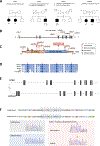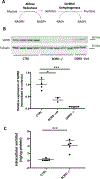Biallelic mutations in SORD cause a common and potentially treatable hereditary neuropathy with implications for diabetes
- PMID: 32367058
- PMCID: PMC8353599
- DOI: 10.1038/s41588-020-0615-4
Biallelic mutations in SORD cause a common and potentially treatable hereditary neuropathy with implications for diabetes
Erratum in
-
Author Correction: Biallelic mutations in SORD cause a common and potentially treatable hereditary neuropathy with implications for diabetes.Nat Genet. 2020 Jun;52(6):640. doi: 10.1038/s41588-020-0649-7. Nat Genet. 2020. PMID: 32457452
Abstract
Here we report biallelic mutations in the sorbitol dehydrogenase gene (SORD) as the most frequent recessive form of hereditary neuropathy. We identified 45 individuals from 38 families across multiple ancestries carrying the nonsense c.757delG (p.Ala253GlnfsTer27) variant in SORD, in either a homozygous or compound heterozygous state. SORD is an enzyme that converts sorbitol into fructose in the two-step polyol pathway previously implicated in diabetic neuropathy. In patient-derived fibroblasts, we found a complete loss of SORD protein and increased intracellular sorbitol. Furthermore, the serum fasting sorbitol levels in patients were dramatically increased. In Drosophila, loss of SORD orthologs caused synaptic degeneration and progressive motor impairment. Reducing the polyol influx by treatment with aldose reductase inhibitors normalized intracellular sorbitol levels in patient-derived fibroblasts and in Drosophila, and also dramatically ameliorated motor and eye phenotypes. Together, these findings establish a novel and potentially treatable cause of neuropathy and may contribute to a better understanding of the pathophysiology of diabetes.
Conflict of interest statement
Figures




Comment in
-
Elevated sorbitol underlies a heritable neuropathy.Nat Genet. 2020 May;52(5):469-470. doi: 10.1038/s41588-020-0619-0. Nat Genet. 2020. PMID: 32367057 No abstract available.
References
-
- Carr AS, Pelayo-Negro AL, Evans MR, Laurà M, Blake J, Stancanelli C, et al. A study of the neuropathy associated with transthyretin amyloidosis (ATTR) in the UK. J Neurol Neurosurg Psychiatry. 2016June;87(6):620–7. - PubMed
Publication types
Grants and funding
- I 4699/FWF_/Austrian Science Fund FWF/Austria
- MR/T001712/1/MRC_/Medical Research Council/United Kingdom
- DH_/Department of Health/United Kingdom
- MR/179744/MRC_/Medical Research Council/United Kingdom
- 110043/Z/15/Z/WT_/Wellcome Trust/United Kingdom
- WT_/Wellcome Trust/United Kingdom
- 204841/Z/16/Z/WT_/Wellcome Trust/United Kingdom
- R01 NS105755/NS/NINDS NIH HHS/United States
- R61 AT010408/AT/NCCIH NIH HHS/United States
- U54 NS065712/NS/NINDS NIH HHS/United States
- R21 GM119018/GM/NIGMS NIH HHS/United States
- R01 NS072248/NS/NINDS NIH HHS/United States
- R01 NS075764/NS/NINDS NIH HHS/United States
LinkOut - more resources
Full Text Sources
Other Literature Sources
Molecular Biology Databases
Miscellaneous

